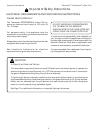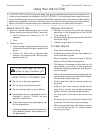Special offers from our partners!

Find Replacement BBQ Parts for 20,308 Models. Repair your BBQ today.

Thermador
®
Professional
®
Indoor GrillCare and Use Manual
Using Your Indoor Grill
7
Excessive Flaming or Flare Ups
This Professional Indoor Grill is equipped with two
20,000 BTU/HR U-shaped burners to provide the high
heat and uniform temperature distribution required
for quality grilling. The intense heat, however, may
result in flareups due to drippings of grease and fat.
This is a normal part of the cooking process. It is
imperative that the grilling process be supervised at
all times, so that the user can oversee this active
cooking method.
Should the flame become excessive, remove the food
from the grill and turn the control knob to OFF. Use
baking soda to extinguish the flames. Excessive
flaming may occur when cooking meat with a lot of
fat (i.e., 30% ground beef, steaks with a heavy fat layer
around the edge, lamb chops, etc.)
Use caution when turning any kind of meat. The melted
fat dropping onto the stainless radiant may create a
flare-up. If a flare-up occurs, use a long handled spatula
to move food to another area until the flames subside.
Follow these steps to light the grill burners
manually:
1. Turn off all the burners.
2. Wait 5 minutes to allow any accumulated
gas to dissipate.
Use a long stem match or a multipurpose
long disposable lighter to light manually:
3. Remove the grill grates.
4. Find the ports on top of the burner by
looking through the opening at the end of
the radiant. Keep your hands and face as
far away from the burner as possible.
5. Place the lighted long-stem match or
lighter through the hole in the radiant.
This positions it near the burner ports.
6. Turn the knob to the LITE position. The
burner will light within 4 to 10 seconds.
LIGHTING INSTRUCTIONS
for Manual Lighting
– Read Before Lighting –
Grilling Hints
◆ DO NOT leave the grill unattended while
cooking.
◆ The doneness of meat, whether rare, medium
or well done, is affected to a large degree by
the thickness of the cut. Expert chefs say it is
impossible to have a rare doneness with a thin
cut of meat.
◆ The cooking time is affected by the kind of
meat, the size and shape of the cut, the
temperature of the meat when cooking begins
and the degree of doneness desired.
◆ Use a spatula or tongs instead of a fork to turn
the meat. A spatula will not puncture the meat
and let the juices run out.
◆ To get the juiciest meats, add seasoning or salt
after the cooking is finished and turn the meat
only once (juices are lost when the meat is
turned several times). Turn the meat just after
the juices begin to bubble to the surface.
◆ Trim any excess fat from the meat before
cooking.To prevent steaks or chops from curling
during cooking, slit the fat around the edges
at 2-inch (51 mm) intervals.
◆ To test for doneness, make a small slash in the
center of the meat, not at the edge.This
prevents loss of juices.
◆ To prepare rarer meats or maintain warmth,
place the food at the front section of the grill.


















